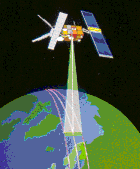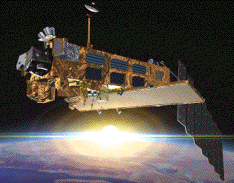|
Reactive
bromine in the atmosphere
DOAS
BrO Retrievals
BrO
Product Validation
On-going
developments
Contact
page last modified:
Tue 01 August 2017 |
DOAS BrO Retrievals
 GOME on board of ERS-2 GOME on board of ERS-2
|
The technique used to retrieve total columns of atmospheric trace species such as BrO from GOME and SCIAMACHY
measurements is the Differential Optical Absorption Spectroscopy (DOAS). The DOAS technique was first developed in the late seventies for ground-based remote sensing [Platt, 1994, and references therein].
Since the early nineties, BIRA-IASB has used developed experience in using this technique for ground-based UV-visible
remote sensing of atmospheric composition. This experience has been and is now being applied to the data analysis
of GOME and SCIAMACHY data.
|
|
The spectral analysis is
performed using WinDOAS, a multi-purpose DOAS analysis software developed
over the nineties at BIRA-IASB. This software initially developed for ground-based
applications has been thoroughly validated through participation at various intercomparison
exercises [Hofmann et al., 1995; Roscoe et al., 1999; Aliwell et al., 2002]. A
version of the programme can already be obtained by contacting the
authors. An overview of the software is also possible by downloading the Software
User Manual (PDF format, 1.3 MB). This manual is a little bit out of date.
These pages provide you with specific information on the DOAS retrievals from GOME and SCIAMACHY
measurements as well as a quick comparison between both.
|

Envisat satellite, artist's impression
|
Acknowledgements
These activities are
or have been supported by ESA/ESRIN (TEMIS project),
the Belgian Federal Office for Science Policy (BELSPO)
and the ESA
Prodex programme. Special thanks go to Claus ZEHNER from ESA-ESRIN. The SCIAMACHY research is supported by the SCIAMACHY validation team.
This work would
not have been possible without numerous discussions and helpful interaction with
other groups involved in the GOME activities, in particular, the
University of Bremen, the
University of Heidelberg and the Harvard-Smithsonian
Center for Astrophysics (SAO). The
ERS-2 GOME operational level-1 product have been processed at DFD/DLR
on behalf of ESA.
Satellite image credits: © ESA
Envisat: ESA/Denmann production
|


